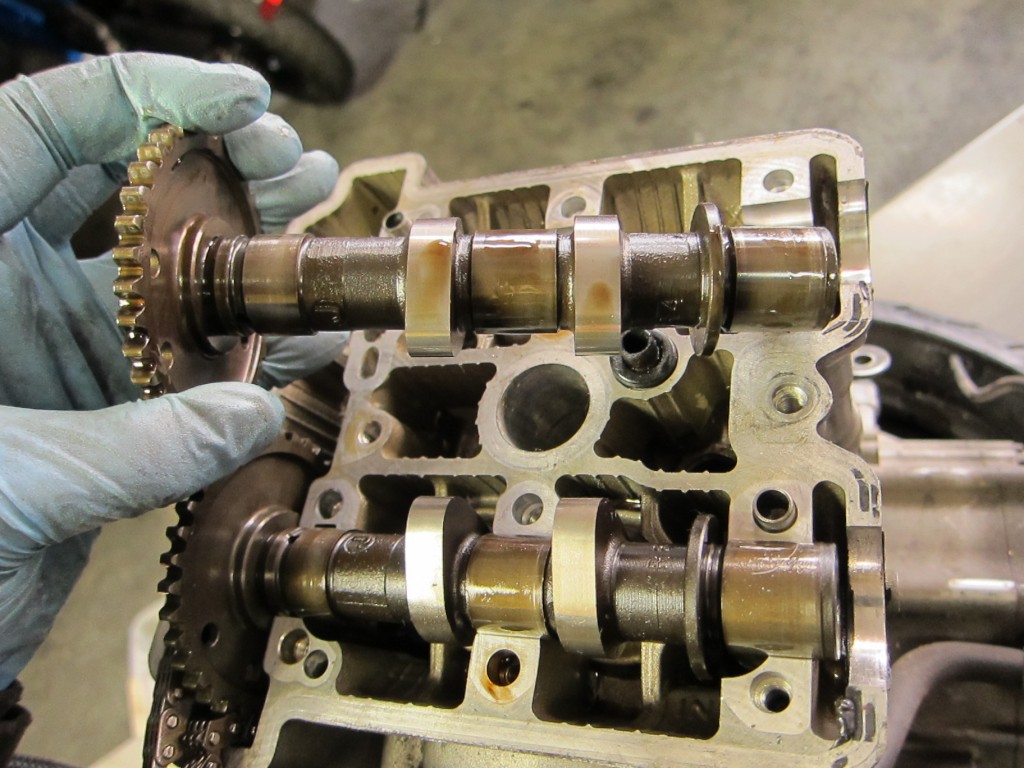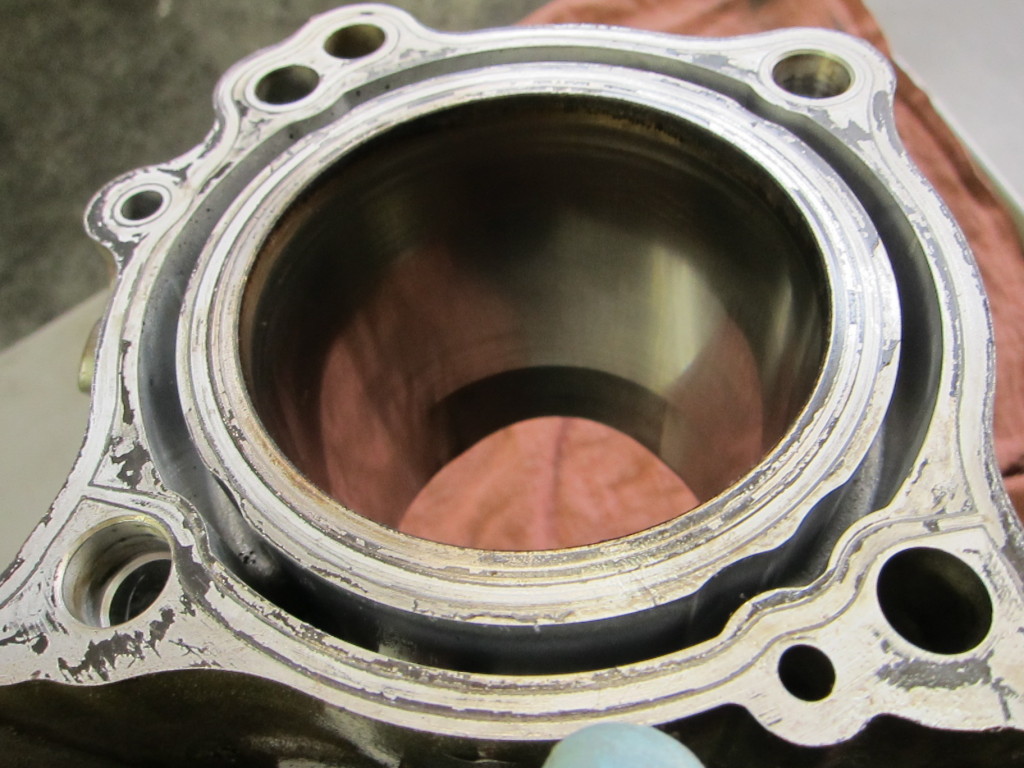Recently, several riders have brought oil-starved bikes into the shop–whether they were new riders or simply neglected to check their oil level for too long, the results have been uniformly disastrous. Motorcycle engines tend to rev high and hot, and like other internal combustion machines, an engine’s metal-to-metal contact points need a consistent film of oil lubrication between moving parts, whether those parts are bearings, camshafts, or piston and cylinder. When the oil level drops below a certain level, it spells certain doom for the bike’s motor–possibly with terrible consequences for the rider. In this case, the V-Strom’s owner ignored the low oil light for approximately 2,000 miles before the bike “began to make a terrible rattling noise” and breathed its last. The unmistakable rattling noise and the sparkling bits of metal in the oil confirmed to us that the motor was in bad shape. Turned out that the engine was damaged beyond repair; we found a replacement engine and installed it, and the rider learned an expensive lesson in responsible bike maintenance.
Riders–remember to check your oil level and keep your bike filled to the appropriate level! The engine is the heart of a bike, and oil is its lifeblood.

The engine from a 2007 Suzuki V-Strom 650--the same bike featured in the oil change tutorial This one, however, was ridden by its uninformed owner until it was dry of oil

Another view of the V-Strom engine--note that the front cylinder has already had its valve cap removed in an effort to diagnose the problem.
It’s painful but fascinating to dig into a ruined engine like this and do a sort of autopsy to discover which parts failed. This is the normally very robust vee-twin engine on the lift, ready for disassembly. It’s a messy, dirty job, so I’ve got gloves on and plenty of rags and a pan on hand to catch spills.
First I loosened the bolts and eased out the starter motor.
Next, off came the valve cap on the forward cylinder head, and then I removed the camshaft journal covers. In both cases, the caps should be removed in a star pattern to prevent the aluminum from warping as it is removed.
In order to loosen the cam chain and remove the camshafts, the cam chain tensioner needs to come off first.
At this point, the camshafts are exposed, and the cam chain is loose and can be pulled off, releasing the camshafts. The cam lobes, which rotate and push the valves open and closed, are vulnerable when the bike’s oil runs dry, as are the camshaft journals, which turn inside their bearings in the engine head. Upon inspection, though, the entire surface of both the intake and exhaust camshafts showed no evidence of wear or galling, a testament to the toughness of the V-Strom engine.
With the camshafts removed, the valve tappets (or buckets) are exposed, easy to pull with a pair of needlenose pliers or a magnet. Since the V-Strom uses a shim-under-bucket valve design, each shim sits on the underside of each tappet. The small shims require care and a deft hand to avoid dropping into the engine, a bad scene if you’re doing a valve adjustment.
Generally, as here, the small shim adheres to the underside of its tappet, and comes out with it.
With the camshafts, tappets and shims gone, the valve ends and the tops of the valve springs can be seen.
The head bolts came out next–that took a breaker bar.
The intake and exhaust valves showed no obvious signs of being bent, a frequent result of oil starvation.
Now that the head was off, the cylinder and piston face were visible.
With the head bolts out, I was able to pull and inspect the cylinder.
The interior of the cylinder shows some scoring.
Normally, the piston rides up and down the cylinder in a thin film of oil. But when the oil is gone, there’s direct metal-to-metal contact as the piston begins to scrape and gouge the cylinder–and you can see the results.
The piston skirt had signs of scoring beginning to show as well. If the engine had not been shut off when it was, the gouges would have deepened in both the metal of the cylinder and the piston, eventually breaking one or both, or melting them together and seizing the engine.
I repeated the process with the other cylinder.
This piston, too, showed little to no damage, unlike the front cylinder’s piston.
The two rear cylinder camshafts were in fine shape, as well.
After the cylinders were removed, the stator cover was next.
With a bit of convincing with the deadblow hammer, the stator cover and stator came away, resisting as the flywheel magnets attempted to hold the stator in place.
With the stator cover off, I flipped the engine over to take off the clutch cover on the other side.
The clutch cover came off more easily, showing the clutch basket beneath.
And next, I unbolted the clutch basket itself and removed it.
Now with the friction plates and steels out, the basket lay beneath. I pressed down the folded-up tabs of the washer holding the nut and friction bearing, and took them out.
With the clutch basket gone, the deeper parts of the crankcase are exposed (the plastic gear is the oil pump gear).
With the top end of the engine (cylinders, valve head, camshafts and covers) apart, and the side covers, stator and clutch removed, it was time to get into the depths of the crankcases and see what damage had been wrought in the engine’s bottom end–which I’ll cover in the next post.































Thanks for the tutorial! I have a couple questions.
1. Is a K&N filter as good as a genuine Honda filter? Honda (of course) claims theirs is the best and made differently than all other filters. Obviously they want us to buy their parts, but at the same time I DO feel that Honda ORIGINAL parts tend to be among the best. I understand that the K&N filters are convenient because of the nut mounted on the front, but aside from that convenience do you feel the filters themselves are just as good?
2. Since there’s a lot of talk about putting bike up on a jack/stand while doing the work (and someone posted a comment about a DIY workaround of putting front wheel up on a curb to allow a lot more work space underneath the bike), it begs the question: Which is the best position for the bike to be tilted for best oil drain? (Level, Tilted back to front, or front to back). With most cars, it’s best to have the front of car raised to allow best oil drain.
3. Lastly, just to clarify. You have stated numerous times that the replacement oil should not say “Energy Conserving”, but that other than that, any kind of motor oil (correct viscosity) is fine. However, several other posts I’ve read have stated that MANY motor oils (including O’Reilly’s) contain MOLYLUBES, even if they do state anywhere on the container that it’s energy conserving, and those who posted have stated that any oil containing Molylubes CAN cause a clutch to slip. I know you have said that you personally have never had that problem, but what is your opinion of that statement by other posters? Can Molylubes, at least with SOME bikes, cause the clutch to slip?? It has me thinking it might be worth it to just pay a few bucks more and buy original Honda oil just to make sure. Would really appreciate your opinion of what some have stated about molylubes even though you have not personally experienced that problem. Does it make sense???
Thanks so much!!!
Awesome page was just looking for some help on repairing the top end/ bottom end on a kx 125 that ran with no oil. Found this page very helpful! cheers
Nice blog. To occure damage, how much less oil an engine need to be damaged? I was running my new bike with the oil just a little bit over the minumum mark and i realy got worried. I just added around 300ml almost to full.
Very good blog, thanks for sharing!
Good work.
Thanks for sharing.
Cheers,